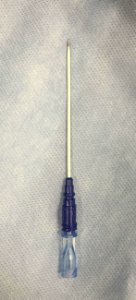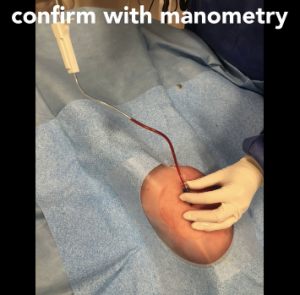Today we bring you a compilation of several tips to make your next central line go more smoothly. Interns and 2nd years will probably find these tips most useful, but you’d be surprised how much you can pick up even as you get further on into residency.
1. Prepare your own sterile flushes.
If you’re like me, you’ve spent an annoying amount of time searching through your ED for sterile flushes for your lines. Somehow, they never seem to be there when you need them, and we all know that our typical flushes are only sterile on the inside, right? So here’s what you do: empty a few flushes out into the sterile blue plastic before you gown and glove, and then you can use a sterile syringe from your kit to draw it up when you’re ready. Simple, huh?
2. Velcro your own gown.
This one takes a bit of flexibility. Open the gown, find the collar, and reach up to velcro it before you put your hands into the sleeves. Then you continue to glove and prepare as normal. Start doing yoga if you need to, this one’s worth it. Don’t forget to put on your mask and lunchlady hairnet first.
3. Use the wire-through-catheter technique.
Most of us were taught to use the large finder needle to get flash, stabilize it with our hand while we unscrew the syringe, and then pass the wire. A better method is to use the separate needle with a pre-loaded catheter:
Hook this up to a syringe and find the vein as normal. Then advance the catheter over the needle and withdraw the needle just like a peripheral IV, leaving you an open channel into the patient’s vein. This technique is further detailed in Reuben Strayer’s video here. This sets you up for step 4.
4. Use a piece of IV tubing to do manometry and confirm your placement.
Hook up a short length of standard IV tubing to the catheter and drop the end below the patient’s heart so it will fill with blood. Then, raise it above the patient’s heart. If you’re in the vein, the blood will begin to flow back into the vein:
If you’re in the artery, you’re probably already soaked with blood, and raising the tubing above the heart will not stop the flow. This method is also detailed in the above video. Once you know you’re in, you can continue as normal by putting the wire through your catheter.
Other tips:
Unkinking your wire: When you momentarily drop your wire (still sterile) or it falls out of the plastic tip, how do you get it back in? Easy: the wire’s made of an outer metal sheath over a separate metal core, and if you stretch the wire at any point along its length the curve will straighten out. You’re welcome.
Finally, What happens if you puncture an artery during your central line attempt? This happens a lot, so don’t stress too much – between 1% and 11% of attempts in a recent study. In the vast majority of cases, puncture with a finder needle does not cause significant complications. Pull the needle out and apply pressure. On the other hand, DILATION of an artery can cause life-threatening bleeding. ALWAYS use a confirmatory method before dilating your vessel (wire-through-catheter facilitates this).
In the worst case scenario, if you have dilated or even placed a central catheter and then realize you are in the artery, LEAVE IT WHERE IT IS and consult vascular surgery for repair. This is always the safest option if you’re in an artery.
References:
F. Gibson et al. Misplaced central venous catheters: Applied anatomy and practical management. British Journal of Anesthesiology. Feb 2013.
Taira and Lin. Tricks of the Trade – Central Venous Catheters. Medscape. https://www.acep.org/Clinical—Practice-Management/Tricks-of-the-Trade—Central-Venous-Line,-Part-2–Troubleshooting-Tricks/
R Strayer. A Better Central Line Technique: Needle-though-catheter. EM Updates. July 2015. http://emupdates.com/2015/07/11/a-better-central-line-technique-wire-through-catheter/


